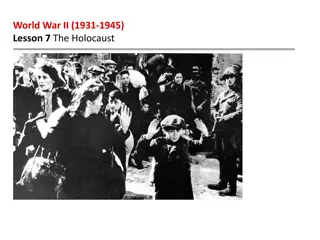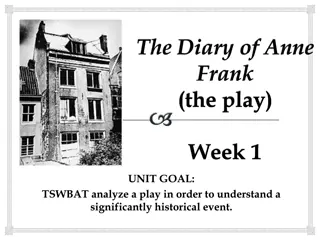Understanding Resistance and Compliance in the Holocaust
Exploring the complex dynamics of why more Jews didn't fight back during the Holocaust, this content delves into the notions of compliance, resistance, and the harsh realities faced by the victims. Through the perspectives of historians such as Raul Hilberg and Yehuda Bauer, it examines the challenging circumstances, Nazi occupation policies, and the limited options available to the Jewish population. The images and insights presented shed light on the multifaceted nature of the Holocaust experience.
Download Presentation

Please find below an Image/Link to download the presentation.
The content on the website is provided AS IS for your information and personal use only. It may not be sold, licensed, or shared on other websites without obtaining consent from the author. Download presentation by click this link. If you encounter any issues during the download, it is possible that the publisher has removed the file from their server.
E N D
Presentation Transcript
PETER HAYES, WHY: EXPLAINING THE HOLOCAUST VICTIMS: WHY DIDN T MORE JEWS FIGHT BACK MORE OFTEN? BIRMINGHAM HOLOCAUST EDUCATION CENTER, JANUARY 30 DR. CLARK HULTQUIST, PROFESSOR OF MODERN EUROPEAN HISTORY, UNIVERSITY OF MONTEVALLO
I. Introduction II. Compliance and Resistance III. The World of the Camps IV. Concluding Thoughts Hehalutz women captured with weapons, Stroop Report, 1943
II. COMPLIANCE AND RESISTANCE Raul Hilberg Jewish Collapse and A Manifestation of Failure Hannah Arendt role of Jewish leaders darkest chapter of the whole dark story Jews did not resist: only meaningful resistance was armed action Jews actually made things worse by trying to survive in other ways than fighting
II. COMPLIANCE AND RESISTANCE Yehuda Bauer rejected both arguments Resistance: any undertaking to frustrate Nazi intentions of harming/killing Jewish people A spectrum of responses Avoid blaming the victims for their fates
II. COMPLIANCE AND RESISTANCE Nazi Occupation of Poland policies 1: Had previous experience in marginalizing Jews in Germany/Austria 2: Colonial Practice Indirect rule through favored natives who gained privilege or exemptions in exchange for controlling everyone else 3: Divide and Conquer hard to resist Coupled with force Appointees could refuse and die now or consent and die later (or not at all) Playing for time Judenrat of Lublin, Yad Vashem
II. COMPLIANCE AND RESISTANCE Why Little Resistance to Deportations? 1. German Camouflage 2. Carrot & Stick, Bait & Threat 3. Delegation to Judenr te 4. Weakened Condition of Jews 5. Viciousness of German reprisals 6. Only recourse: avoid starving to death Jews from the Lodz ghetto are loaded onto freight trains for deportation to the Chelmno killing center, between 1942 and 1944. National Museum of American Jewish History, Philadelphia
II. COMPLIANCE AND RESISTANCE Whether they lived or died depended on two things alone: the actions of the Nazi regime and the progress of the Allied armies Peter Hayes, Why, page 195 British troops, Normandy on D-Day, June 6, 1944. US Holocaust Memorial Museum
III. THE WORLD OF THE CAMPS Arrival Conditions Collective Punishment Presence of spies Escape? Stripping of humanity Exhaustion Self-pity and paralysis
III. THE WORLD OF THE CAMPS Terrence Des Pres, The Survivor (1976) Who outlived the camps? 1. Discovery of purpose 2. Preserving appearance 3. Coping with initial arrival shock 4. Living with & against terms of existence Complete following of rule or defiance meant death Buchenwald (Elie Wiesel), National Archives and Records Administration, College Park, Md.; US Holocaust Memorial Museum
IV. CONCLUDING THOUGHTS BBC: How to Survive a Disaster John Leach, University of Portsmouth In life-threatening situations: 75% of people are so bewildered by the situation that they are unable to think clearly or plot their escape 15% manage to remain calm and make decisions to save their lives 10% break down and hinder others Passivity, mental paralysis, or carrying on as normal in crisis Caused by failure to adapt to a sudden change in the environment Survival involves goal-directed behavior New, stressful environment events happen faster than one can process them Situation outruns capacity to think out of it
I think the story of Kosw is also appropriate. It exemplifies most vividly the refusal of so many Jewish victims to yield their humanity in the face of impending murder. Kos w was a small town in eastern Galicia, and it had a Judenrat which was not very different from others. On Passover, 1942, the Gestapo announced it would come into the ghetto. The Judenrat believed that this was the signal for the liquidation of the ghetto, and told all the Jews to hide or flee. Of the twenty-four Judenrat members, four decided to meet the Germans and offer themselves as sacrificial victims to deflect the wrath of the enemy. With the ghetto empty and silent, the four men sat and waited for their executioners. While they were waiting one of them faltered. The others told him to go back and hide. The three men of Kos w prepared to meet the Nazis on Passover of 1942. Was their act less than firing a gun? Yehuda Bauer, The Jewish Emergence from Powerlessness
































